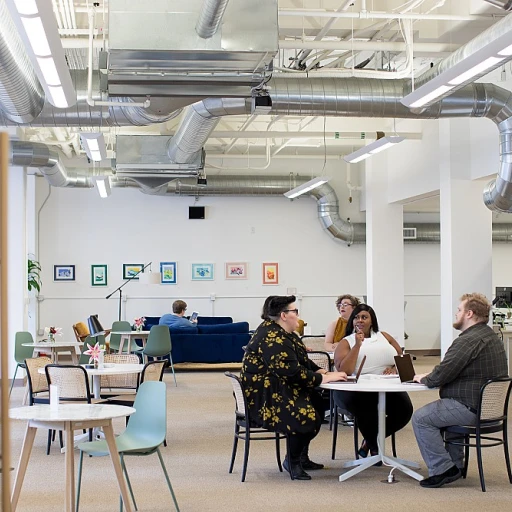Understanding Employee Engagement Technology
The Evolution of Digital Solutions for Employee Engagement
Over the past decade, the landscape of workplace interaction has dramatically shifted, largely due to the advent of employee engagement technology. Aimed at fostering a more connected and motivated workforce, these digital solutions have become an essential part of modern HR strategies. Employee engagement refers to the emotional commitment employees have towards their organization and its goals. Traditionally, engagement was assessed through periodic surveys and personal interactions. With the rise of technology, however, organizations now have access to real-time insights and tools that help in consistently tracking and enhancing engagement levels. The digital transformation of engagement efforts includes an array of sophisticated software designed to improve communication, collaboration, and feedback within teams. These tools are tailored to meet the complexities of modern work environments, offering customizable features and analytics capabilities. When we delve deeper into the specifics in the following sections, we will explore the essential features of engagement software that aid in building a thriving workplace culture and some of the most effective platforms currently available on the market. Furthermore, we'll evaluate how feedback processes can be streamlined for better results and showcase real-world case studies that highlight the success of these technologies in fostering a more engaged workforce.Key Features of Engagement Software
Essential Components of Modern Engagement Solutions
In our current digital age, organizations are seeking to foster deeper connections and improve overall employee satisfaction through advanced technological solutions. Employee engagement software is at the forefront of this transformation, designed to cultivate a more dynamic and participative workplace. But what exactly makes up these sophisticated tools? Firstly, real-time analytics and reporting functionalities form the backbone of engagement software. By leveraging data, companies can gain insights into employee behaviors, preferences, and satisfaction levels. This allows for quick responses to any emerging issues, assisting management in creating a more supportive environment. Another integral feature is personalized communication platforms. These facilitate open and transparent dialogue between employees and leadership, encouraging a culture of feedback and continuous improvement. With user-friendly interfaces and cross-device accessibility, employees can seamlessly engage with their work and peers, regardless of their location. The inclusion of customized performance tracking and goal management tools cannot be overlooked. By setting clear objectives and monitoring progress, employees are likely to remain motivated and committed to achieving personal and team milestones. Automatic reminders and progress notifications keep everyone in sync and working towards common objectives. Finally, employee recognition and reward systems are crucial for maintaining high morale. Recognizing contributions, whether through peer-to-peer recognition, badges, or more tangible rewards, bolsters motivation and reinforces a positive workplace culture. These components together drive engagement software, providing organizations with the necessary tools to ensure a proactive and thriving workplace, seamlessly connecting with broader strategies in improving employee experience and feedback mechanisms.Top Engagement Platforms and Tools
Leading Platforms Driving Employee Engagement
In the digital era, numerous innovative platforms have emerged to help organizations foster meaningful employee engagement. These tools provide features that go beyond simple voting or suggestion systems, offering ways to form genuine connections and enhance workplace satisfaction. Let's explore some of the top platforms that are making waves in the domain of employee engagement. Qualtrics Qualtrics is renowned for its sophisticated feedback mechanisms, seamlessly integrated across various touchpoints in the employee lifecycle. The platform enables organizations to collect, analyze, and act on employee insights in real-time, enhancing engagement through informed decision-making. Its ability to customize engagement surveys ensures that unique organizational needs are met, ultimately driving a more personalized employee experience. TINYpulse TINYpulse is another notable platform in the field, designed with simplicity and effectiveness in mind. It encourages continuous feedback through quick, weekly check-ins, providing managers and leaders with actionable insights to improve their team dynamics. Its focus on transparency and open communication helps employees feel valued and heard, fostering a collaborative culture. Culture Amp Culture Amp stands out with its emphasis on building a strong organizational culture. Offering a suite of tools that cover performance management, employee engagement, and development pathways, Culture Amp creates a holistic approach to cultivating an engaged workforce. The platform empowers leaders and HR professionals to nurture their company's culture based on comprehensive data analysis and tailored action plans. 15Five 15Five leverages the power of weekly reports to keep the communication channels open and active between employees and management. The platform is designed to enhance relationships within teams by encouraging regular discussions about progress, roadblocks, and triumphs. With its strategic focus on personal growth and development, 15Five plays a crucial role in strengthening employee engagement. For an in-depth comparison of these platforms and expert insights on how they enhance the employee experience, you can explore more at enhancing employee engagement with modern experience platforms. These solutions aren't just about having the right technology—they're about creating vibrant, thriving workplaces where employees feel invigorated and recognized. Each of these platforms is a testament to the evolving landscape of workplace technology, underscoring the importance of investing in the right tools to nurture a dynamic and engaged workforce. Whether your focus is on feedback integration, cultural enhancement, or streamlined performance management, these leading platforms provide an array of innovative solutions to meet your organization's specific needs.The Role of Feedback in Employee Engagement
The Vital Role of Employee Feedback in Fostering Engagement
Employee feedback stands as a crucial component in the landscape of employee engagement technology. As organizations strive to elevate their connectivity and communication, the essence of feedback cannot be overstated. It serves as a bridge between employees and management, fostering a two-way dialogue that can lead to more robust engagement and a better workplace atmosphere. Feedback mechanisms within engagement tools are multifaceted, allowing employees to voice their opinions on various aspects of their work environment. Surveys, polls, and real-time feedback options provide avenues for employees to express their thoughts, offering an in-depth view into the employee experience. Technology facilitates this process by making it seamless and routine, ensuring that feedback is not just solicited during annual reviews but becomes part of the ongoing conversation. Effective feedback systems empower employees by giving them a sense of contribution and ownership over their work environment. This psychological investment in the company’s culture and mission can lead to increased motivation and job satisfaction. For management, it is a rich resource for understanding the workforce’s needs, challenges, and aspirations, which is essential for making informed decisions on workplace policies and practices. Moreover, engagement platforms often come equipped with analytical tools that enable organizations to process and analyze feedback data. This allows leaders to identify trends, highlight areas that require improvement, and track progress over time. The ability to transform feedback into actionable insights turns feedback from mere suggestion into a strategic asset. Ultimately, when feedback is harnessed effectively, it creates a loop of continual improvement that benefits both employees and the organization. Incorporating employee insights fosters an inclusive culture, builds trust, and enhances the overall employee experience, leading to higher levels of engagement.Improving Employee Experience with Technology
Enhancing the Workplace Environment Through Technology
Employee engagement technology serves as a vital tool in transforming the workplace environment, fostering a positive and inclusive atmosphere that enhances the overall employee experience. As organizations seek to maintain a competitive edge, the employee experience becomes more crucial than ever in attracting and retaining top talent. Leveraging advanced technological solutions provides companies with unique opportunities to craft an environment where employees feel valued and motivated. Digital platforms offer customizable portals where employees can easily access all necessary resources, such as company updates, HR information, and training materials. This holistic approach enables employees to have a seamless experience, reducing frustration and improving accessibility. Additionally, through personalized dashboards, employees can track their career goals, monitor performance, and engage with professional development initiatives. Through the implementation of appraisal and recognition software systems, companies can create a culture of acknowledgment and appreciation. These tools allow management to recognize employee achievements in real-time, fostering a sense of belonging and motivation among the workforce. The resulting uplift in morale can lead to increased productivity and a substantial improvement in overall workplace satisfaction. Furthermore, technology bridges communication gaps by facilitating collaborative tools that enhance team interaction. With solutions that support virtual collaboration, employees can maintain consistent communication with their peers and managers, regardless of their physical location. This ensures inclusivity and builds a more cohesive team dynamic, essential for remote and hybrid work models. Finally, organizations are progressively integrating wellness programs via engagement platforms to support their employees' mental and physical health. By incorporating features like stress management tools, fitness challenges, and telehealth options, companies not only enhance employee well-being but actively contribute to a supportive and proactive work culture. In conclusion, employee engagement technology acts as a cornerstone for improving the employee experience by fostering a conducive work environment that meets the unique needs of each staff member. By embracing these solutions, organizations are poised to nurture a satisfied, engaged, and high-performing workforce.Case Studies: Success Stories in Engagement
Real-World Examples of Successful Employee Engagement
To truly grasp the impact of employee engagement technology, let's explore some real-world examples where businesses have successfully implemented these solutions. These case studies highlight the transformative power of the tools and strategies discussed in earlier sections.
Case Study 1: Tech Innovators Inc.
Tech Innovators Inc., a leading software development company, faced challenges with employee morale and retention. By integrating a comprehensive engagement platform, they were able to streamline communication and foster a sense of community among remote teams. The platform's feedback feature, as discussed in our earlier section, allowed employees to voice their concerns and suggestions, leading to actionable changes. As a result, the company saw a 30% increase in employee satisfaction scores and a significant reduction in turnover rates.
Case Study 2: Green Solutions Ltd.
Green Solutions Ltd., an environmental consultancy firm, leveraged employee engagement technology to enhance their onboarding process. By utilizing personalized learning modules and interactive tools, new hires felt more connected and informed from day one. This approach not only improved the onboarding experience but also accelerated the integration of new employees into the company culture, as detailed in our section on improving employee experience with technology.
Case Study 3: Retail Giants Co.
Retail Giants Co. implemented a feedback-driven engagement tool to better understand the needs and preferences of their diverse workforce. By actively involving employees in decision-making processes and regularly updating them on company developments, the company cultivated a more inclusive and transparent work environment. This initiative, which aligns with the principles outlined in our discussion on the role of feedback, resulted in a 25% increase in employee engagement scores.
These success stories demonstrate the potential of employee engagement technology to revolutionize workplace dynamics. By adopting the right tools and strategies, companies can create a more engaged, satisfied, and productive workforce.



